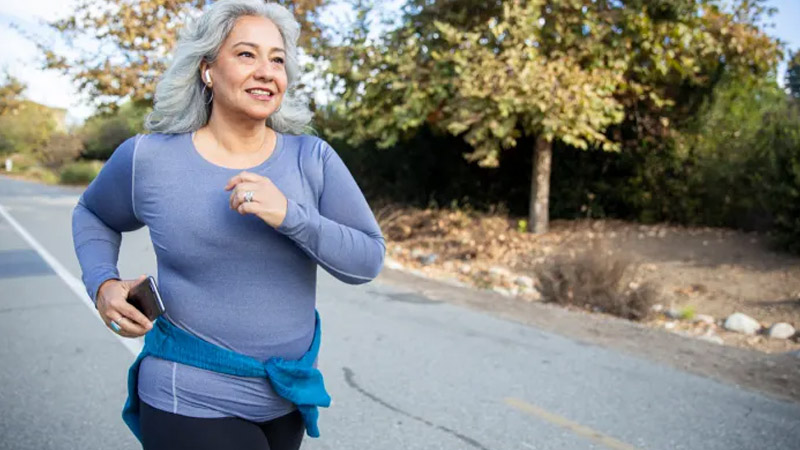When you turn 50, both your mind and body change in a lot of ways. And you may find that you have more brain fog and that it’s getting harder and harder to get rid of belly fat.
“Research shows that a drop in what some people call “fluid intelligence” or “brain fog” is linked to a loss of muscle and an increase in fat in the abdomen,” says Susane Pata, NASM-CPT, a certified personal trainer with the National Academy of Sports Medicine. “The results of a number of studies show that there is a link between body mass index and cognitive function. Obesity in middle age is linked to a decline in cognitive function.”
But adding in exercise can help you beat both brain fog and belly fat.
“Diet and exercise can help mitigate this decline,” says Pata. “The research shows how those with higher abdominal fat measures scored lower on intelligence tests. More exercise can potentially help with this.” And there are many types of exercise that can help.
Best Exercises for Brain Fog and Belly Fat
“The key [is] to get the right type of exercise, the right balance of different types of exercise and to do it consistently—and for the long haul (for life!), in order to lose the excess fat and to keep it off,” says Pata. “It is likely to reduce the amount of adipose tissue on the body and may potentially help reduce cognitive decline.”
According to Pata, three types of exercise that can aid in weight loss:
- Strength training
- Cardio
- HIIT (High-intensity interval training)
Here’s more information about three of the best workouts you can do to get rid of brain fog and belly fat, according to a personal trainer.
Strength training
Specifically, Pata points out that it’s progressive strength training that may have the most impact.
“Try not to keep picking up the same weight for each body part month after month—make the goal to lift heavier and heavier to help increase lean muscle mass,” says Pata. “Strength training that is progressive increases lean muscle mass over time.
So then even while the person is at rest, they may burn more calories than the person who has less lean muscle mass. The more lean muscle mass you have, the higher your basal metabolic rate, which means your body burns more calories at rest.”
Pata also notes that when you build lean muscle mass, there is increased additional energy needed to maintain it.
“All of this lends itself to weight loss. Lower levels of fat and higher levels of lean muscle mass can potentially help alleviate some of the cognitive declines that higher levels of fat impose on the body,” says Pata.
The American College of Sports Medicine guidelines suggest that adults 18-65 should incorporate strength workouts two times or more per week.
Example workout: Total-body strength session (with or without dumbbells).
Equipment needed: Dumbbells (DB) or bodyweight (and with water bottles for certain exercises).
Pata notes that you can start off with bodyweight moves (and probably should if you are starting, or starting again after a long break—also a great way to fix form and technique before adding on the load); but sooner than later start picking up resistance equipment to use with the moves in order to build more lean muscle tissue over time.
Warmup: 5 minutes
- DB squats
- DB chest press (or bodyweight push-ups)
- DB reverse lunges
- Bodyweight plank holds
- DB dead rows (or bodyweight prone Y-raises)
- DB triceps kickbacks (or use water bottles)
- DB bicep furls (or use water bottles)
- DB lateral raises (or use water bottles)
Cool down: 5 minutes
Related: The Best Food for Brain Fog
Cardio
According to Pata, cardio includes brisk walking, jogging or running; swimming; cycling; a game of pickleball, and more. “Cardio can include bodyweight circuits as they can help with cardiorespiratory fitness,” she explains.
The American College of Sports Medicine guidelines suggest that adults 18-65 should incorporate cardio workouts of a minimum of 30 minutes, five times per week. Or, you could opt for more vigorous cardio for just 20 minutes, twice per week.
“If just walking, keep it brisk and continuous. If wanting to advance to jogging or running, introduce increments of time spent doing jogging or running intervals (30 seconds, one minute, three minutes, etc.) in between walking before doing a full-on running workout,” says Pata.
“Start running with slow speeds to maintain proper mechanics; increase the time before speed in order to practice the basics and become more resilient; increase speed once the longer duration runs start to feel easier and repeat the cycle.”
Example workout: Running
- Warm-up: Walk 5 minutes
- Slow run: 5 minutes
- Moderate run: 20-40 minutes
- Slow run: 5 minutes
- Cool down: Walk for 5 minutes
HIIT (High-intensity interval training)
“HIIT is short spurts of high-intensity activity for brief amounts of time immediately followed by ‘much needed’ recovery (as in, you cannot do another thing because you’ve just exercised to the point of true exhaustion) after the high-intensity work you just did that left you breathless,” explains Pata.
HIIT can help you reduce both brain fog and belly fat.
“High-intensity interval training imposes a huge caloric burn when performed correctly,” says Pata. “The more calories you burn, the greater the weight loss (including fat), which can potentially help alleviate some of the cognitive declines that higher levels of fat impose on the body.”
Example workout: Total-body HIIT Session (with or without dumbbells)
Equipment needed: Dumbbells (DB) for some moves if looking to progress
- Warm-up: 5 minutes
- Workout: 30 seconds on/30 seconds to 1 minute off; 4 sets of each:
- Jump squats
- Push-ups with dumbbell rotation
- High knees
- Alternating lunge jumps (option to hold a dumbbell close to chest)
- Dead rows with heavy dumbbells
- Burpees
- Skaters
- Cool down: 5 minutes



